Turn your favorite gingerbread cookie into a delicious and tender gingerbread scone. Spiced with cinnamon, ginger, and sweetened with molasses, these yummy scones will put you in a holiday mood with every bite!

Jump to:
Why this recipe works
- Richly flavored with molasses, ginger, and cinnamon, these Christmas scones are perfect for any time of day
- These ginger scones have a soft, chewy texture, just like gingerbread cookies, with a bit of crunch from coarse sugar
- The vanilla icing adds more bright sweetness to offset the deep molasses flavors
Fall and Winter seem to be the time when treats made with molasses come to the fore - you might see Shoofly Pie (aka Molasses Pie) and molasses cookies on holiday tables.
Then there are the gingerbread treats. Whether you like gingerbread cookies to shape into gingerbread people or build a gingerbread house, it's a wonderful way to celebrate the holidays.
And let's not forget about a delicious gingerbread loaf! Soft and flavorful, it's a festive treat (pssst...my gingerbread recipe has a secret - I use sourdough discard in the batter, and no one is the wiser!).
So what if we incorporate those warm and spicy gingerbread flavors into a holiday scone? Friends, I give you Gingerbread Scones!
These gingerbread scones have a lovely rich flavor that just makes you think of soft gingerbread cake or gingerbread cookies. They're the perfect Christmas scone to start off your day with a cup of coffee or tea, or really, have one any time of day!
They won't be quite as tall and flaky as other scones, like cream scones or pumpkin scones, because the molasses is very thick and moist. However, a gingerbread scone will have a tender and chewy texture offset by a bit of crunch from the coarse sugar.
The vanilla icing adds more bright sweetness to offset the deep molasses flavors - it's the icing on the...uhm...scones, as it were!
If you love gingerbread, you're going to love these gingerbread scones!
Recipe ingredients
You'll need the following ingredients to make this gingerbread scones recipe:

Ingredient Notes
The basic scone ingredients are here: all-purpose flour, baking powder, salt, butter, egg, and a liquid to bring it all together (heavy cream and molasses, in this case). There's also a vanilla icing made from powdered sugar, vanilla extract, and heavy cream.
Molasses: The major flavor in gingerbread! Like with Molasses cookies or Shoofly Pie, it's the molasses that provides its big flavor to a gingerbread scone. Use a mild-flavored (light) molasses, not the blackstrap variety. The flavor is bold enough.
Brown sugar: Helping to sweeten these molasses scones, light brown sugar adds its molasses flavor as well.
Butter: How you cut up your butter isn't as important as keeping it cold. Generally I'll grate frozen butter on a box grater before cutting it into the flour mixture. You can also cut chilled butter into small ½-inch cubes. Either way, make sure the butter is well chilled before cutting it into the flour mixture.
Baking soda: In addition to the usual baking powder, we need the extra lift that baking soda provides to counteract the denseness of the molasses.
Spices: Ginger, cinnamon, and cloves are present and help to give these gingerbread scones their distinctive flavor.
Coarse sugar: I like to add a little crunch to the top of scones by sprinkling coarse sugar on the dough before baking. It's optional, but worth it.
See the recipe card for a full list of ingredients and measurements.
How to make gingerbread scones
Step 1: Make the dough
In a large bowl, whisk together the flour, sugar, baking powder, ginger, baking soda, salt, cinnamon, and cloves (photo 1).

Toss the butter into the flour mixture to coat, then use a pastry blender, two forks, or your hands to work the butter into the flour until coarse, pea-sized crumbs appear (photo 2).
Don't overdo this step as you don't want the butter to warm up and mix completely into the flour.

In a separate small bowl, whisk together the molasses, egg yolk, and heavy cream until smooth (photo 3)

Slowly add the molasses mixture to the flour mixture and mix until the dough just holds together (photo 4).
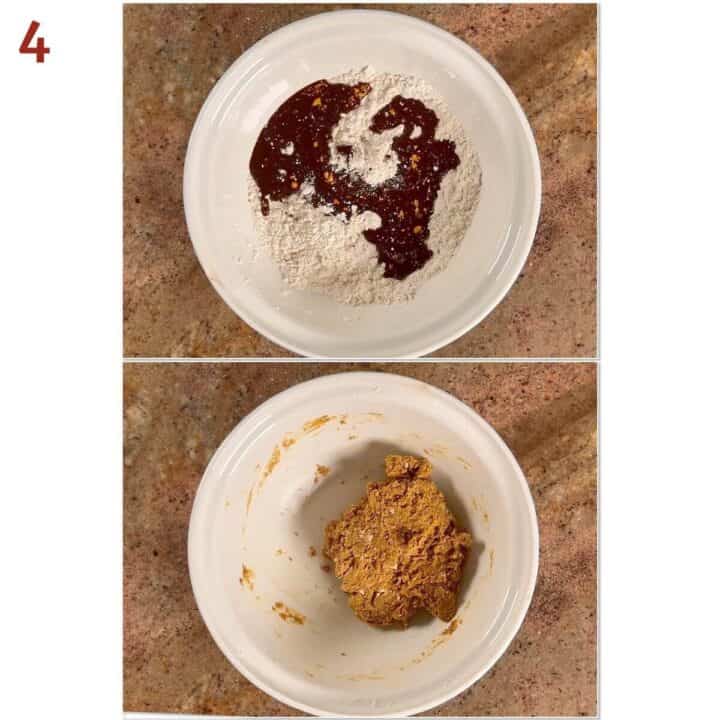
Step 2: Shape the scone dough
Line a half baking sheet pan with a Silpat silicone mat or parchment paper.
Transfer the dough to the prepared baking pan and shape it into a 6-inch disk, about ¾-inches high.
Brush the top of the dough with the egg white, then sprinkle on the coarse sugar, if using.
Using a knife or bench scraper, slice the disk into 8 wedges (photo 5)

Step 3: Chill and bake the dough
Pull the pieces away from the center of the disk so that they're about 1-inch apart at their outer edges.
Place the uncovered scone-filled baking pan in the freezer for 30 minutes. This will allow the butter to firm up before baking.
Bake the scones for 15 to 18 minutes, or until they're light brown (photo 6).
Transfer the scones to a cooling rack while you make the icing.
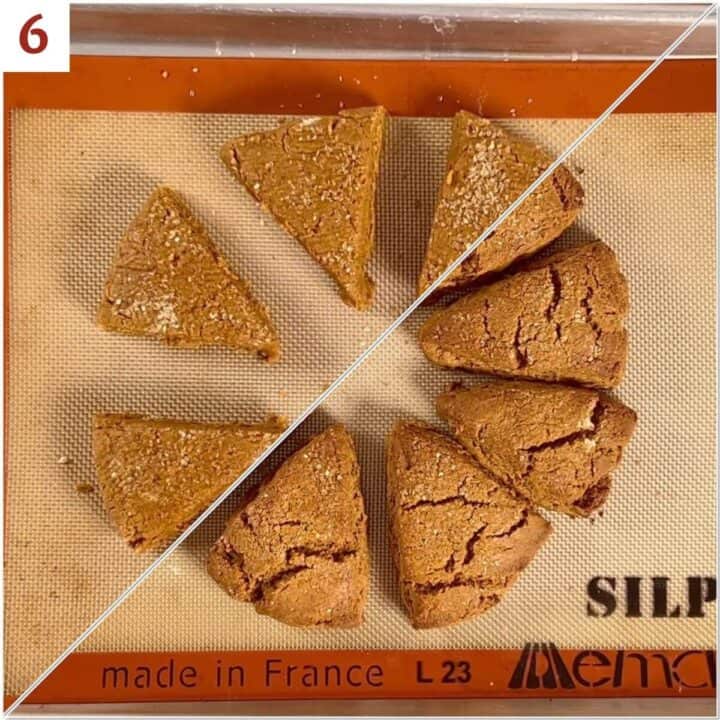
Step 4: Ice the scones
Sift the powdered sugar into a small bowl, then add the vanilla extract and 1 tablespoon of milk. Stir until the icing is smooth and leaves a trail when drizzled into the bowl. You might need to add an additional tablespoon of milk to get the right consistency (photo 7).

Drizzle the icing onto the cooled scones and let it set before serving (photo 8).

Storage and make-ahead instructions
Storage instructions: Baked scones are best enjoyed right away, though leftover scones keep well at room temperature or in the refrigerator, stored in an airtight container, for about 3 to 5 days. They also freeze well, in an airtight bag, for up to 3 months. Thaw overnight in the refrigerator then warm to your liking before enjoying.
Make-ahead instructions: For freshly baked scones anytime, freeze unbaked shaped scones on a wax paper-lined baking pan until solid, then place in an airtight bag for up to 6 months. Take out as many as you want to bake (there's no need to defrost them first), and bake at 375 °F for 17 to 20 minutes. Drizzle with icing if desired.
Tips for scone success
Here are two important tips to insure you'll get successful scones!
- Do not over mix the dough: You want to keep that butter cold and separate from the flour as much as possible. Using a bowl scraper will help to combine the dough in the bowl without your hands warming up the butter, plus you can see any crumbs at the bottom that still need to be mixed in.
- Chill the dough: Chilling the dough before baking will allow the butter to firm up if it has softened during mixing, leading to higher-rising scones with a crumbly texture.

Questions asked and answered
Here are some questions you might have...
The best way to make sure you have scone success is to be sure not to over-work the scone dough by cutting in the butter too much. You want the dough to have pea-sized chunks of butter that you can see. Chilling the dough right before baking also helps to firm up the butter before baking.
Why? Like with biscuits, cold chunks of butter in the dough ensure that the scone will have the texture you want. This is because when the scones bake, the steam created by the water in the butter evaporating makes the flaky, crumbly texture that scones are known for.
Yes! Heavy cream just makes the scones richer, but you can use any type of milk or milk-alternative that you'd like. The same holds true with the butter - you can use a butter substitute like Earth Balance. However, I wouldn't recommend using coconut products because that flavor could interfere with the gingerbread flavors here.
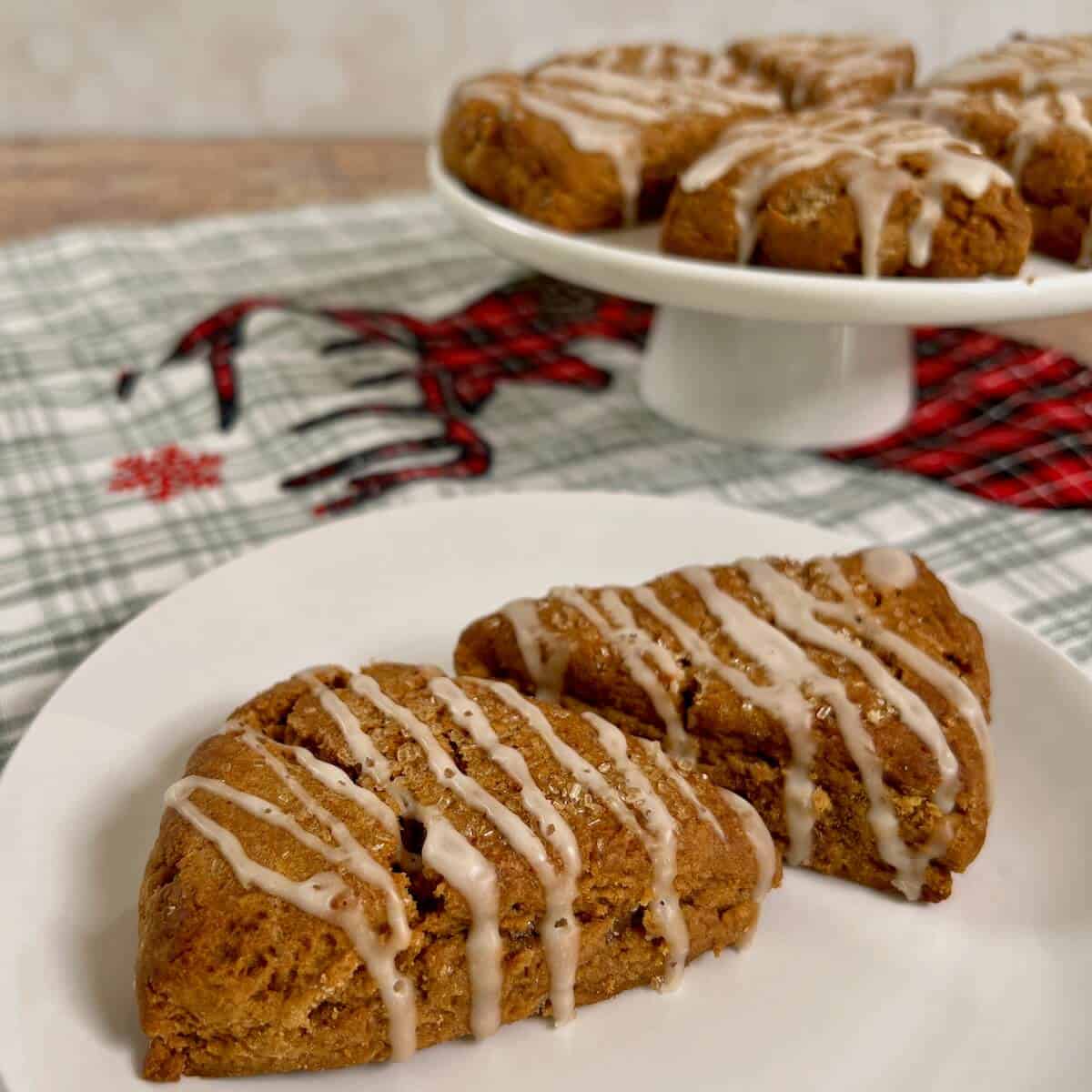
More biscuit and scone recipes to try
Recipe

Gingerbread Scones
Equipment
Ingredients
For the scones
- 2 cups all-purpose flour
- 3 tablespoons light brown sugar, packed
- 2 teaspoons baking powder
- 1 teaspoon ground ginger
- ½ teaspoon baking soda
- ½ teaspoon kosher salt
- ½ teaspoon ground cinnamon
- ¼ teaspoon ground cloves
- 6 tablespoons unsalted butter, cold, see Recipe Notes
- ⅓ cup molasses
- 1 large egg yolk, beaten
- ¼ cup heavy cream, see Recipe Notes
- 1 large egg white, lightly beaten
- coarse sugar, for sprinkling, optional
For the icing
- ½ cup powdered sugar, sifted
- ½ teaspoon pure vanilla extract
- 1 to 2 tablespoons milk, as needed
Instructions
- Preheat the oven to 400 °F. Line a half baking sheet pan with a Silpat silicone mat or parchment paper. Set aside.
- Make the scones: In a large bowl, whisk together the flour, sugar, baking powder, ginger, baking soda, salt, cinnamon, and cloves.
- If the butter is frozen, grate it using a box grater. Otherwise, cut the butter into small cubes.
- Toss the butter into the flour mixture to coat, then use a pastry blender, two forks, or your hands to work the butter into the flour until coarse, pea-sized crumbs appear. Don't overdo this step as you don't want the butter to warm up and mix completely into the flour.
- In a separate small bowl, whisk together the molasses, egg yolk, and heavy cream until smooth.
- Slowly add the molasses mixture to the flour mixture and mix until the dough just holds together. Using a bowl scraper will help to combine the dough in the bowl without your hands warming up the butter, plus you can see any crumbs at the bottom that still need to be mixed in. Remember, do not over mix the dough - you want to keep that butter cold and separate from the flour.
- Transfer the dough to the prepared baking pan and shape it into a 6-inch disk, about ¾-inches high.
- Brush the top of the dough with the egg white, then sprinkle on the coarse sugar, if using. Using a knife or bench scraper, slice the disk into 8 wedges. Pull the pieces away from the center of the disk so that they're about 1-inch apart at their outer edges.
- Place the uncovered scone-filled baking pan in the freezer for 30 minutes. This will allow the butter to firm up before baking.
- Bake the scones for 15 to 18 minutes, or until they're light brown. The edges of the scones should look baked, not wet or doughy. Transfer the scones to a cooling rack while you make the icing.
- Make the icing: Sift the powdered sugar into a small bowl, then add the vanilla extract and 1 tablespoon of milk. Stir until the icing is smooth and leaves a trail when drizzled into the bowl. You might need to add an additional tablespoon of milk to get the right consistency.
- Drizzle the icing onto the cooled scones and let it set before serving.
- Storage instructions: Baked scones are best enjoyed right away, though leftover scones keep well at room temperature or in the refrigerator, stored in an airtight container, for about 3 to 5 days. They also freeze well, in an airtight bag, for up to 3 months. Thaw overnight in the refrigerator then warm to your liking before enjoying.
- Make ahead instructions: For freshly baked scones anytime, freeze unbaked shaped scones on a wax paper-lined baking pan until solid, then place in an airtight bag for up to 6 months. Take out as many as you want to bake (there's no need to defrost them first), and bake at 375 °F for 17 to 20 minutes. Drizzle with icing if desired.




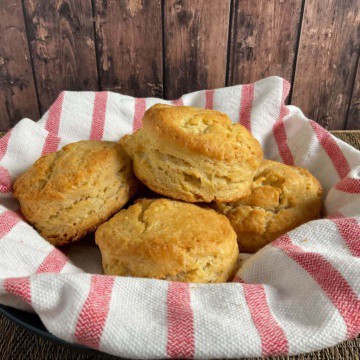
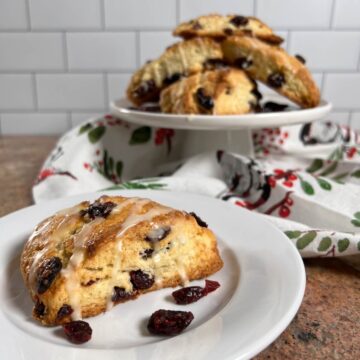


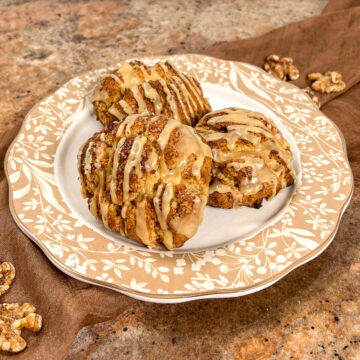
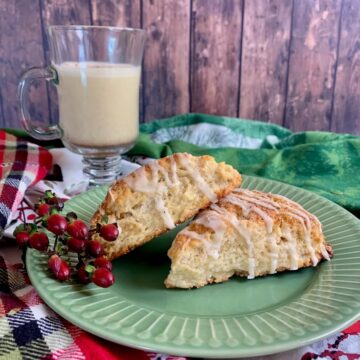


Tammy Spencer says
I enjoyed creating this recipe for you, and I hope you like it as much as I do. Please leave your questions or comments with a star rating so that other readers can benefit from your experience. Thanks!